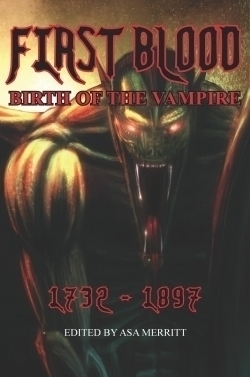First Blood
Birth of the Vampire
Once upon a time, vampires were not the sole literary domain of Twilight. As *First Blood: Birth of the Vampire—*an anthology of classic vampire literature—demonstrates, vampires have been ensnaring imaginations for centuries, and have become, in the process, the subjects of short stories, novellas, and poems, several of which have contributed to our modern, Western conception of vampires.
Spanning the seventeenth and the eighteenth centuries, First Blood nicely traces the evolution of the brykolakas. Divided into three parts—A German Dusk, The Crossing, and Dracula: The Vampire Unleashed—it begins with the German roots of the vampire literary tradition, covers a transitional period that solidifies the typical characteristics of the vampire (foreign, aristocratic), and ends with Dracula, which heralds the start of the modern era of vampire literature and establishes the vampire as a symbol of subconscious cultural fears.
The first section of the book starts with “Visum et Repertum,” an Austrian military report published in 1732 that details the case of a thought-to-be dead Serbian soldier who returns from the grave to attack and kill people. Versed in vampire lore, the villagers drive a stake through his heart to kill him.
Following “Visum et Repertum,” series of eighteenth-century poems begin to use the undead as a means of moral investigation. Of these, Sir Walter Scott’s “William and Helen” stands out as an entrancing work of lyricism. The heroine, Helen, goes nearly insane with grief when her William does not return from war with the other soldiers:
“Wild she arraigns the eternal doom,
Upbraids each sacred power,
Till, spent, she sought her silent room,
All in the lonely tower.”
Unaware that her fiancé has just joined the undead, her desperation leads her to join him on a terrifying night ride to her morbid bridal bed.
Though the collection is worth reading as a whole, other highlights include Coleridge’s “Christabel,” Polidori’s “The Vampyre: A Tale,” and sections from the absurdist penny dreadful, “Varney the Vampire: Or, The Feast of Blood.” LeFanu’s “Carmilla” is at once haunting and hard to put down.
First Blood will appeal to and is a worthwhile read for scholars (and vampire addicts) who are interested in the subject’s cultural evolution.
Reviewed by
Lia Skalkos
Disclosure: This article is not an endorsement, but a review. The publisher of this book provided free copies of the book and paid a small fee to have their book reviewed by a professional reviewer. Foreword Reviews and Clarion Reviews make no guarantee that the publisher will receive a positive review. Foreword Magazine, Inc. is disclosing this in accordance with the Federal Trade Commission’s 16 CFR, Part 255.

